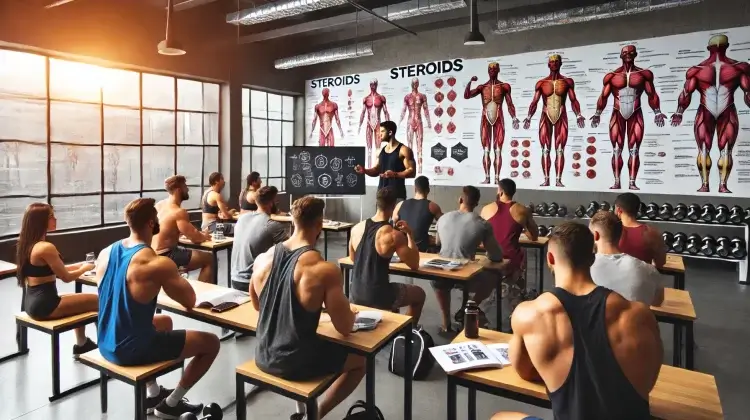
Steroid expert Type-IIx explores the complex universe of anabolic-androgenic steroid compounds, each with unique features and effects. While all AAS share a common ancestry with testosterone, the fine distinctions between different classes reveal a nuanced landscape worthy of deeper exploration.
The Basics: Common Features of AAS
Fundamentally, all AAS are derivatives of testosterone. They promote protein synthesis, influence the development of male secondary sexual characteristics such as body hair growth and voice deepening, and suppress the production of luteinizing hormone (LH), follicle-stimulating hormone (FSH), and sex-hormone binding globulin (SHBG). These commonalities form the backbone of their biological action, creating a broad spectrum of overlapping effects.
Beyond the Basics: Key Distinctions Among AAS
Upon closer examination, certain distinctions emerge within this sea of similarities. The U.S. Food and Drug Administration (FDA) categorizes drugs into classes based on a combination of three factors:
- Mechanism of Action (MOA)
- Physiologic Effect (PE)
- Chemical Structure (CS)
In this series, we classify AAS primarily by their chemical structure, followed by notable physiological effects and mechanisms of action. This classification helps illuminate the subtle differences that define each class.
AAS Classes by Chemical Structure
- Trienes (Δ4,9,11 androgens)
- Heterocyclically-ringed (typically additional rings, e.g., furazane or pyrazole, attachments to the A-ring)
- Androst-4-ene-3-ones (classical androgens more like testosterone that tend to aromatize and either 5α- or 5β- reduce due to their C-4,5 double-bonded sterane structure unless another feature opposes these metabolic pathways)
- 5α-androstan-3-ones (nonaromatizable, non-5α-reducible androgens)
- Androst-1-ene-3-ones (“1-enes”; these C-1,2 double-bonded androgens generally present a decreased androgenic and to a lesser degree anabolic potency yielding a favorable anabolic-androgenic ratio)
- Androsta-1,4-dienes (“1,4-dienes”; more saturated A-ring androgens)
- 2-enes (highly unusual, lacking the 3-keto group, for which the O atom has a lone pair of electrons allowing its action as a H-bond acceptor, able to interact with polar or charged amino acids to form strong bond with the N-terminus/amino-group of the AR)
Unique Drug Effects: Distinctions Beyond Classification
Some AAS possess drug-specific effects that go beyond their class characteristics. These unique features can arise from particular attributes of the compound’s mechanism of action, physiological effects, or chemical structure. For example, fluoxymesterone, known for its 11β-hydroxylation and 9α-fluoronation, binds antagonistically to the glucocorticoid receptor (GR). This unusual property gives it an anticatabolic effect more akin to a glucocorticoid than a typical androgen, highlighting the complexity of its action.
Conclusion
The landscape of anabolic-androgenic steroids is diverse and intricate, with each class and compound offering unique properties and effects. By understanding these distinctions, we gain a clearer picture of the potential applications and implications of AAS in various contexts.
The Steroid Insight Series Overview
Trienes (Δ4,9,11)
- 1. Trenbolone: insulin sensitivity, augments muscle satellite cell proliferative response to IGF-I, tissue-level antiglucocorticoid effects (decreased GR number), atherosclerotic and pro-inflammatory (antagonizing MR).
Heterocyclically-ringed
- 2. Stanozolol (Winstrol): Drying-out effect, long biological half-life.
androst-4-ene-3-ones
- 3. Fluoxymesterone (Halotestin): [5α-reduction] Particularly reductive of fat mass, systemic antiglucocorticoid effect (competitive inhibition of GR).
- 4. Trestolone (MENT): [aromatization] Particularly suppressive (decreased LH, FSH).
- 5. Testosterone: [aromatization & 5α-reduction] Bioidentical.
- 6. Nandrolone (Deca durabolin; NPP): [aromatization & 5α-reduction] Joint benefits (increased type I collagen deposition), depression and learning, memory deficits (increased homovanillic acid).
5α-androstan-3-ones
- 7. Oxandrolone (Anavar): A 2-oxasteroid. Particularly lipolytic, enhances hepatic ketosis.
- 8. Methasterone (Superdrol): 2α-methylation dramatically increases anabolic and reduces androgenic potency, most toxic commercially available AAS (resistant to metabolism & potent 17AA).
1-enes (androst-1-ene-3-ones)
- 9. 1-Testosterone (Dihydroboldenone): Increases DHT (perhaps via 17β-HSD1 inhibition but not 5α-reduction), increases C-reactive protein either directly or by requiring guaiacol to hold in solution.
1,4-dienes (androsta-1,4-dienes)
- 10. Metandienone (Dianabol): [aromatization] Decreases ACTH (antiglucocorticoid effect), potently suppressive, potently hematopoeitic.
2-enes (no 3-keto group)
- 11. Epistane: Acts partly as a prodrug to desoxymethltestosterone (Madol), potently antigynecomastic.
About the author
Type-IIx is a physique coach, author, and researcher. Bolus: A Practical Guide and Reference for recombinant Human Growth Hormone Use will be his first published textbook, anticipated for release in early 2023. Ampouletude.com will be Type-IIx's base of operations for coaching services and publications. Type-IIx is proud to be a contributing writer to MesoRx, his home forum, where he is a regular poster.
